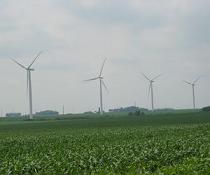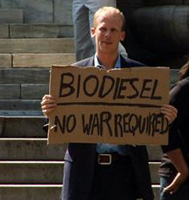Twelve grants totaling $25 million were awarded today by Florida Agriculture and Consumer Services Commissioner Charles H. Bronson as part of the state’s “Farm to Fuel” initiative.
“We believe that awards such as these are critical in triggering the development of a renewable energy industry in Florida,” Bronson said. “With the backing of and an investment from the state, we’re hopeful that these projects will yield positive results and serve as a catalyst for major commercial investment in this industry.”
 The winners of this year’s “Farm to Fuel” grants are:
The winners of this year’s “Farm to Fuel” grants are:
Gulf Coast Energy of Walton LLC
Awarded $7 million, in a commercial project grant for the construction and operation of both an ethanol and biodiesel plant in a $62 million project in Mossy Head, Florida
U.S. Envirofuels LLC
Awarded $7 million, in a commercial project grant for the construction of a $47 million ethanol production plant in Highlands County.
Liberty Industries
Awarded $4 million, in a commercial project grant for the construction and operation of a $38 million Liberty County facility that will produce ethanol and electricity using primarily forest waste products.
Agri-Source Fuels
Awarded $4 million, in a commercial project grant for the construction of a $21 million biodiesel plant in Pensacola.
University of Florida
Awarded $500,000, in a research and development grant to develop a catalytic chemical reactor system to convert woody biomass to biodiesel.
Southeast Biofuels LLC
Awarded $500,000, in a demonstration grant to build a nearly $6 million pilot plant in Auburndale to produce ethanol from citrus peels.
Sigarca Inc.
Awarded $499,500, in a research and demonstration project involving the construction of a 3,000-square-foot bioenergy plant on the grounds of the Southeastern Livestock Pavilion in Ocala to process horse waste into renewable energy.
University of Central Florida
Awarded $498,000, in a research and development grant to demonstrate the viability and cost effectiveness of technology developed at the university to convert farm and animal waste into renewable energy.
Florida Institute of Technology
Awarded $415,520, in a research and development grant to cultivate and research various strains of Microalgae capable of producing biodiesel.
Applied Research Associates Inc.
Awarded $203,130, in a research and development grant involving converting cellulosic materials such as sugarcane byproducts to fermentable sugars for a more cost-effective way of producing ethanol.
Applied Research Associates Inc.
Awarded $182,832, in a research and development grant to demonstrate a new technology in converting crop oils into biodiesel.
Neptune Industries Inc.
Awarded $158,270, in a research and development project that would create a pilot-scale floating algae production system in quarry lakes in South Florida to produce algae capable of being converted into biodiesel.
 The move is being applauded by the Canadian Renewable Fuels Association in this press release:
The move is being applauded by the Canadian Renewable Fuels Association in this press release: “Over the next few weeks biodiesel will be put to the ultimate extreme cold weather iron man test,” said Gordon Quaiattini, President of the Canadian Renewable Fuels Association. “We are confident these tests will confirm adverse condition tests in the USA and Europe, and will reconfirm biodiesel as a viable tool in diversifying our energy supply and reducing green house gases.”
“Over the next few weeks biodiesel will be put to the ultimate extreme cold weather iron man test,” said Gordon Quaiattini, President of the Canadian Renewable Fuels Association. “We are confident these tests will confirm adverse condition tests in the USA and Europe, and will reconfirm biodiesel as a viable tool in diversifying our energy supply and reducing green house gases.”

 The first large-scale ethanol plant in Texas opened this week in Hereford.
The first large-scale ethanol plant in Texas opened this week in Hereford.  ESPN’s Winter X Games 12 is set to begin on Wednesday, and organizers say, despite the mountains of snow, it will be greener than ever. It’s not global warming taking its toll… it’s green fuel.
ESPN’s Winter X Games 12 is set to begin on Wednesday, and organizers say, despite the mountains of snow, it will be greener than ever. It’s not global warming taking its toll… it’s green fuel. You can catch all of the action January 24-27 at Buttermilk Mountain in Aspen, Colorado on ESPN. Click
You can catch all of the action January 24-27 at Buttermilk Mountain in Aspen, Colorado on ESPN. Click  Dan Goodman is preaching, and his disciples are students who spread the word even further. But he’s not a minister at a pulpit. He has a non-profit venture called Biodiesel University that gives students hands-on experience producing the renewable fuel, while educating consumers on the benefits of biodiesel.
Dan Goodman is preaching, and his disciples are students who spread the word even further. But he’s not a minister at a pulpit. He has a non-profit venture called Biodiesel University that gives students hands-on experience producing the renewable fuel, while educating consumers on the benefits of biodiesel.
 “Although our title is Biodiesel University, the lessons in general should be about environmental stewardship and getting kids excited about the environment and technology. It’s unusual that a school would be able to afford or get to have a lot of industrial-grade cutting edge stuff at the school.”
“Although our title is Biodiesel University, the lessons in general should be about environmental stewardship and getting kids excited about the environment and technology. It’s unusual that a school would be able to afford or get to have a lot of industrial-grade cutting edge stuff at the school.” Among the investors is Andy Blunt, pictured in the AP photo with his brother Gov. Matt Blunt. So far, he is holding on to his shares as plant officials try to negotiate a compromise with State Treasurer Sarah Steelman. State Rep. John Quinn of Chillicothe also owns shares in the plant and he believes the treasurer’s office should relax its policy, perhaps allowing up to 5 percent of investors to have political connections.
Among the investors is Andy Blunt, pictured in the AP photo with his brother Gov. Matt Blunt. So far, he is holding on to his shares as plant officials try to negotiate a compromise with State Treasurer Sarah Steelman. State Rep. John Quinn of Chillicothe also owns shares in the plant and he believes the treasurer’s office should relax its policy, perhaps allowing up to 5 percent of investors to have political connections.  The winners of this year’s “Farm to Fuel” grants are:
The winners of this year’s “Farm to Fuel” grants are: Some schools in Minnesota are getting educated to the power of wind energy, as they look to stretch their dollars to meet the demands of rising energy costs.
Some schools in Minnesota are getting educated to the power of wind energy, as they look to stretch their dollars to meet the demands of rising energy costs. Patents for biofuels dominated renewable energy patents in 2007… outdistancing patents for solar and wind combined.
Patents for biofuels dominated renewable energy patents in 2007… outdistancing patents for solar and wind combined. Researchers at Old Dominion University in Norfolk, Virginia are looking at a new way of turning algae into biodiesel.
Researchers at Old Dominion University in Norfolk, Virginia are looking at a new way of turning algae into biodiesel.  A documentary about biofuels makes its world premiere at the
A documentary about biofuels makes its world premiere at the  “Fields of Fuel”
“Fields of Fuel”